
Mid-Century Murano Glass Blackamoor Candelabra Pair with Aventurine Detail
A pair of mid-century Murano glass Blackamoor candelabra, kneeling to one knee and holding a candle sconce in each hand, with aventurine detail. Minor old chipping and repair, height 37 cm.
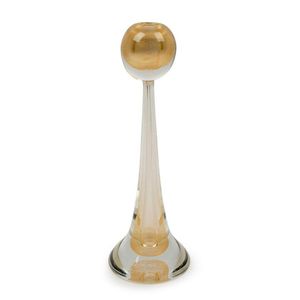
Gino Cenedese Murano Glass Candlestick with Gold Inclusions, 31cm
Gino Cenedese Murano glass candlestick with gold inclusions, engraved 'Gino Cenedese. 17/05/89. Ve', 31 cm high
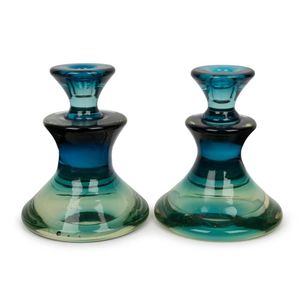
Murano green and blue glass candlesticks, Cenedese, 17 cm high
Cenedese pair of Murano green and blue glass candlesticks, 17 cm high
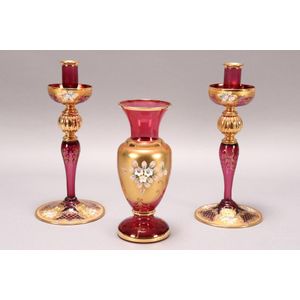
Cranberry Murano Glass Vase and Candlesticks with Gilt Decoration
Murano glass vase and candlesticks, in cranberry coloured glass with gilt and enamel foliate overlay decoration, comprising baluster vase, height 25.5 cm, and pair of candlesticks on a wide sloping base, height 32 cm, a/f (crack to one bowl of…

Murano Glass Figural Candelabra: Kneeling Figure with Sconces
Murano figural glass candelabra, depicting a figure kneeling on one knee holding a sconce in each hand, in tones of red, black, white and gilt, height 33 cm

1950s Murano Green & Red Sommerso Glass Candelabra - 27.5cm
Murano green and red sommerso glass candelabra, circa 1950s, 27.5 cm high, 18 cm wide

Murano Fish Detail Ruby Glass Candlesticks Set
Two Murano ruby glass candlesticks with fish detail, height 14 cm to 19 cm
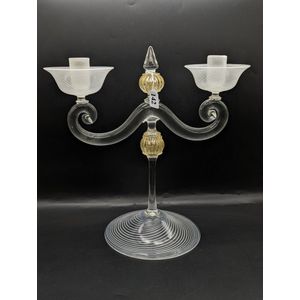
Latticino Swirl Glass Candelabra with Gold Aventurines
Venetian glass candelabra, twin branch latticino white swirls with clear stem scrolled branches with gold aventurines., height 32.5 cm
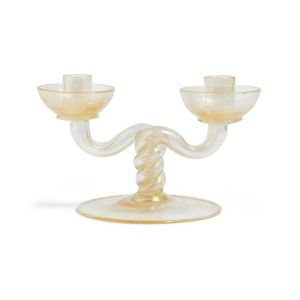
Murano Glass Candle Holder with Gold Inclusion by Barovier & Toso
Barovier & Toso candle holder, Murano glass with gold inclusion. Hollow twisted stem and arms. Italy, c 1940s, 13 cm high, 23 cm wide, 13 cm deep.

Michael Barrymore's Murano Glass Candlestick
Murano glass candlestick. Provenance: from the Michael Barrymore collection. Sold at Art and object in April 2008, 50 cm high

Murano Pink and Gold Glass Dish Set
Murano Barbini dish with Tumber and candle holder, encased pink and gold glass 13 cm diameter, 7.5 cm high, 10 cm diameter (tumber and candle holder with faults) together with triple layer pink shaped shallow dish 24 cm diameter
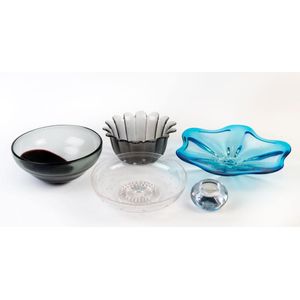
Assorted Glass Bowls and Candle Holder Collection
(6 items), the Stuart Crystal bowl 26.5 cm diameter Stuart Crystal fruit bowl, glass candle holder, blue Murano glass fruit bowl, art glass bowl and a glass bowl with floral design, 20th century, (5 items), the Stuart Crystal bowl 26.5 cm diameter

Gilded Venetian Blackamoors with 6-Branch Candelabra
A pair of parcel gilt Venetian Blackamoors with six branch candelabra, second half 20th century each electrified six-light candelabrum with opposing ebonised and gilded standing figures raising a flambeau issuing six scrolling branches terminating in…

Murano Venetian Candle Sticks with Purple Swans
A pair of Murano Venetian candle sticks, fine cirtrine glass with central purple swans (wax stopper, missing to one)

Gold Leaf Murano Glass Candle Holders, 32cm Height
Murano glass candle holders pair of gold leaf details with lipped and dotted decoration, height 32 cm
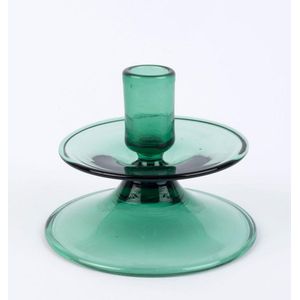
Green Murano Glass Candle Holder by Seguso
Seguso (attributed) green Murano glass candle holder, 10 cm high, 14 cm diameter

Venetian Ruby Glass Decorative Set
Two similar Venetian ruby glass decorative pieces, each of ruby glass with applied clear glass decoration, including a decorative candlestick, height 23 cm and a footed vase, height 28 cm

1950 Barovier & Toso Murano Glass Candelabra - 29cm
Barovier & Toso Murano glass candelabra, circa 1950, a??29 cm high, 25 cm wide

Seletti Morpheo Modular Candelabra & Murano Glass Candle Holders
Seletti 'Morpheo modular Candelabra' the colour collection, pair of Murano glass candle holders in original boxes, 24 cm high

Regency Ruby Glass Candelabra with Enamel Decoration
Venetian ruby glass enamelled candelabra, three branch with gold fleck stem, Regency decorated with enamel

Pink Murano Glass Candle Holders by Archimede Seguso
Archimede Seguso (1909-1999) a pair of pink Murano glass candle holders; circa 1950s, cylindrical with striated ribbed sides, original labels to base. Height 12.5 cm, width 5.5 cm

Vintage Venetian Blackamoor Floor Lamps
A pair of vintage Venetian blackamoor floor lamps, painted, silvered and gilded gesso over wood, each holding gilded six branch electrified candelabra. Height 170 cm.

Gold Inclusions Candelabra by Barovier & Toso
Barovier & Toso Murano glass candelabra with aventurine gold inclusions, circa 1950, 24 cm high, 25 cm wide

Barovier & Toso Murano Glass Comport & Candlesticks Set
Barovier & Toso Murano glass comport and matching candlesticks, circa 1950, (3 items), remains of original paper labels, the comport 17 cm high, 24 cm diameter, the candlesticks 24 cm high
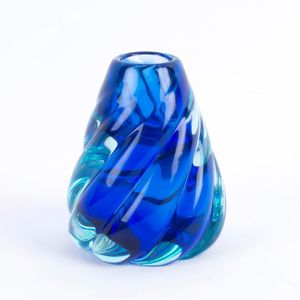
Blue Murano Glass Candlestick by Seguso, 1950s
Seguso, blue sommerso Murano glass candlestick, circa 1950's, original label 'Made By Archimedes Seguso, Murano...', 10 cm high

Murano Glass Face, Mushroom, and Candleholder Trio
Three various art glass items comprising a Murano glass face wall plaque 2 small chips to edges, a Murano glass mushroom shape paperweight, and a clear glass candleholder, height 18.5 cm, tallest

Amethyst Swan Candlestick by Salviati Murano
Salviati Murano yellow art glass candle stick depicting amethyst colour swan, height 35 cm
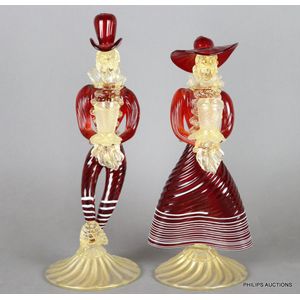
Red Venetian Glass Figural Candlesticks (10 words exactly)
A pair of red Venetian glass figural candlesticks, second half 20th century, the male and female figures each holding a single sconce, the lady's skirt in a spiral decor with complete white threading, embellished with 'Gold dust' aventurine inclusions and…

Venini Murano Glass Candelabra Pair, 1950s
Venini Murano glass pair of two branch candelabra, Italian, circa 1950s, original label 'Venini, Murano, Venezia, made in Italy', 20.5 cm high

Blue Decorated Venetian Glass Candlestick - 29cm Height
Venetian glass candlestick clear glass column with blue glass decoration, height 29 cm approx.

Gold Aventurine Candlestick - 24cm Height
Murano gold flecked candlestick aventurine decorated, height 24 cm
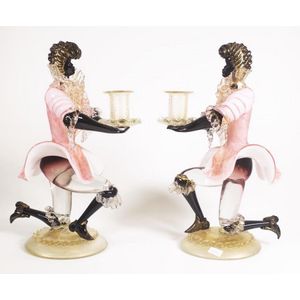
Blackamoor Murano Glass Candlesticks with Pink Costumes
Pair of good Murano glass Blackamoor candlesticks maker: Barovier & Toso, with pink 'foglia d'oro' costumes, with aventurine candleholders and circular bases, height 32 cm

Murano Green Glass Candlestick with Gilt Decoration
Murano overlay glass candlestick, with green glass panels, over clear glass acented with gilt decoration, original label verso, height 19 cm

Vintage Venetian Silver Gilt Candlesticks
A pair of vintage Venetian wood turned silver gilt candlesticks. 45 cm high, 19 cm wide, 19 cm deep

Venetian Glass Candlesticks - 20th Century
A pair of Venetian glass candlesticks, 20th century, 29 cm high
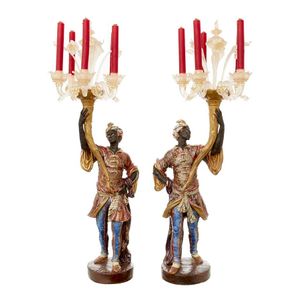
Gilded Ceramic Blackamoor Candelabra by Pattarino
A pair of Professor Eugenio Pattarino (Italian 1885-1971) impressive ceramic blackamoor candelabra, hand painted and gilded ceramic, the Venetian glass branches with gilded inclusions, including finial 120 cm high. Provenance: The collection of a Curator…

Gilded Blue Glass Candlesticks by Cenedese Murano
A pair of Cenedese Murano gilded blue glass candlesticks, each with a wide flared bobeche decorated with gilded vine a leaf and branch motif, seated on a clear glass node and blue glass baluster stem with frilled clear glass applications, terminating on a…
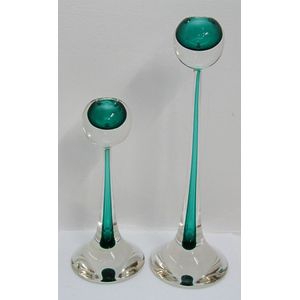
Murano Glass Tulip Candlesticks by Gino Cendese
Two Murano graduated green and clear glass tulip design candlesticks, Gino Cendese scripted signature to base. 26 cm and 37 cm high.

Venetian Dolphin Glass Candle Holders (19th Century)
Set of four 19th century Venetian dolphin glass candle holders (slight A/F)

Emerald Green Murano Glass Candelabrum
An emerald green Murano glass candelabrum, second half 20th century, the slender baluster and gold flecked knop form candlestick of ribbed design, with an applied arching arm supporting two nozzles and surmounted by a bell form cup, the whole raised upon…
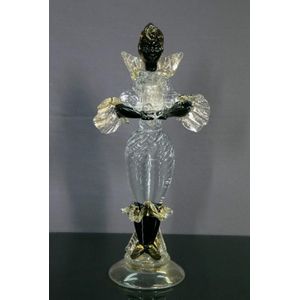
Signed Murano Glass Candle Holder Figure by Badioli
Murano glass figure form candle holder. Mario Badioli (b.1940). Signed to base. Height 32 cm

Murano Peacock Candlestick & Crystal Vases Set
Murano glass peacock candlestick with gold inclusions 20 cm high, together with a pair of crystal posy vases with SW maker's mark to base
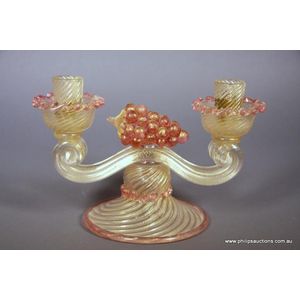
Gold Dust Murano Glass Candlestick
A Murano spiral decor glass candlestick, circa 1950s, the pedestal candlestick with a curvaceous arm surmounted by a bunch of grapes and supporting two bell form dishes and nozzles, the clear glass decorated throughout with a dusting of gold aventurine…

Mid-century Murano Glass Candlestick with Bird and Foliate Scroll
A Murano glass candlestick, mid-20th century, unmarked, the single light raised on a stylized foliate scroll, an opposing scroll supporting a figure of a small bird in pale green glass with bands of mica, all on an indented circular base. Height 14 cm.…



 Loading more...
Loading more...